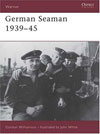PROCESSING POWs
As the North African campaign wore on, tens of thousands of prisoners were being taken from the battlefields. The initial stages of processing was little more than a thorough search for weapons. Few American soldiers at the front lines spoke German and even when they did, they found that some prisoners, recruited from Poland, Finland, France, Serbia, Hungary, and the Ukraine spoke little German themselves. Initially the prisoners were simply disarmed and moved out of the combat zone.|
US National Archives - 88196
 A POW from U-352 being fingerprinted
A POW from U-352 being fingerprinted
|
The processing compounds at Marrakech, Oran, and Casablanca were expanded to hold the increasing number of POWs. With the arrival of POWs from the Sicilian and Italian campaigns, by the late spring of 1944, the Army was handling more German and Italian prisoners than there had been American soldiers in the entire pre-war U.S. Army.
Prisoners were first put through a basic medical examination. Seriously wounded prisoners were immediately transferred to military hospitals and received excellent care.
Next the POWs were assigned serial numbers which were used throughout their internment. The numbers consisted of two components. The first part of the serial number designated the theater in which the prisoner had been captured. For example, the number 81 meant North Africa; 5 indicated the Western Defense Command; and 31 meant the European Theater. Directly following this number came a letter indicating the country in whose army the prisoner had served. A German soldier captured in North Africa would carry the first part as 81G-; an Italian captured in Europe would have the designation of 31I-; an Austrian taken in Europe would be assigned 31A and so on. The second part of the serial number was an individual number assigned consecutively to the POW upon capture. A German veteran of the North African campaign might carry the serial number 81G-5849.
Thousands of prisoners were transported to the United States before a serial number could be assigned. For these prisoners the system of identification was different. The first component of the serial number contained three symbols: the number of the Army Service Command-numbered 1 to 9, representing the military districts into which the U.S. was divided, "W" for War Department, and the first letter of the country for which the prisoner served. A German processed in Oklahoma or Texas was assigned 8WG-1234.
Each prisoner was required to fill out a three-page form (basic personnel record) which requested his personal and medical history, fingerprints, serial numbers, an inventory of personal effects, and information about his capture. This form became his personal record, copies of which were forwarded to the International Red Cross so that the prisoner’s family could be informed of his fate. When the form was completed he was an official prisoner of war.
The major problem during the initial stages of processing was the language barrier. Most of the military’s competent German and Italian speaking personnel were working in the Intelligence units and other vital areas. As a result, the prisoners sometimes took advantage of the language barrier and ignored commands or confused the registration process. In some instances prisoners were able to apply fingerprints to another prisoners photo while attached to a third prisoners form. Important officers or prisoners with valuable intelligence information were theoretically able to slip through the registration simply because guards and clerk-typists were unable to penetrate the language smokescreen and, out of frustration, would wave the prisoner through. The War Department understood the problem but was simply unable to improve the ratio of translators to prisoners until late in the war.
|
US National Archives - 71623
 U-boat men in captivity in the South Atlantic
U-boat men in captivity in the South Atlantic
|
This problem was also evident in the U.S. where German speaking personnel were even more scarce. Camp commanders sometimes had to deal with upwards of 8,000 POWs with a single translator. With only two options, rely on Engish-speaking prisoners or allow the prisoners to run themselves the Army chose assistance from the English speaking prisoners to help them.
Another problem was attempting to segregate those prisoners who beliefs in Nazism were deep-seated and unchangeable from those which were only opportunistic or transitory. Initially prisoners were separated by service branch: Army personnel were separated from Air Force and officers from enlisted men. American authorities took only the most visibly rabid Nazis, a total of only 4,500 by 1945, and interned them at Alva, Oklahoma, while the most visibly anti-Nazis, 3,300 total, were shipped to Fort Devens, Massachusetts and Camp Campbell, Kentucky.




